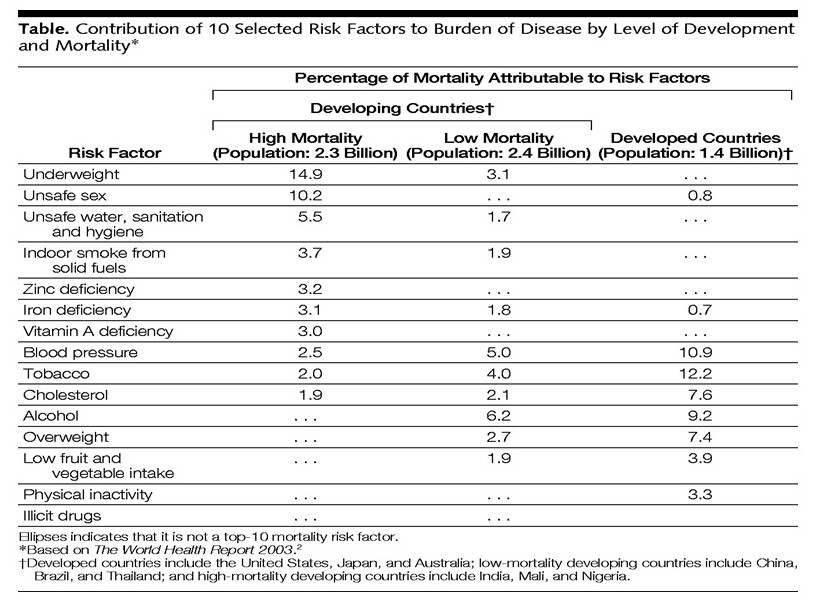Introduction
Yach, Hawkes, Gould, and Hofman, (2004) article states that “chronic diseases are the principal causes of death and disablement worldwide.” While the causes of chronic diseases depend on several factors or causes, individual adaptable behaviors perform significant functions in both risk and prevention. A high number of world inhabitants are excessively affected by chronic diseases.
These primary diseases have the same fundamental risk factors: the use of tobacco, physical activity deficiency, unhealthy diets, and alcohol consumption (Table 1) (World Health Organization, 2002). The present difficult concern of chronic diseases reveals a precedent experience of these risk factors, and the prospective concern will be resolved by the recent exposures.
This paper evaluates the understanding, risk, and prevention of chronic diseases.

Literature Review on Chronic Diseases
Chronic diseases are the principal causes of death and disablement worldwide and are responsible for 7 of every ten deaths. The five principal chronic diseases are cardiovascular disease (CVD), cancers, stroke, chronic obstructive pulmonary diseases, and diabetes. These diseases affect the standard of living of most people thereby, causing most worldwide deaths (Yach, Hawkes, Gould, & Hofman, 2004). According to the Center for Disease Control and Prevention (CDC), cardiovascular disease, cancer, and stroke together cause almost 60% of all deaths worldwide (CDC, 2004). In addition to personal and family adversity, there is an economic effect of chronic disease. The result of international economic factors on the threats of these diseases obstructs growth, as does the course of health schemes to acute care.
In 2004, the cost of healthcare for people with chronic diseases was almost 75% of the world health care budget (CDC, 2004). Although management of chronic diseases in general and costly, it is among the most preventable.
The etiology of the chronic disease depends on several factors. However, a constant connection has been established between an individual’s modifiable behaviors (e.g., smoking, lack of physical activity, poor nutrition) and the possibility of developing chronic disease.
In their original report, Yach, Hawkes, Gould, and Hofman, (2004) described the main modifiable risk issues for the chronic disease and characterized them as “actual causes of death.” However, an epidemiological move from transmittable disease to chronic disease, including significant changes of lifestyle during the 1990s, led to a reconsideration of the modifiable causes of death worldwide (Mokdad, Marks, Stroup, & Gerberding, 2004). According to the estimates of these authors, the real causes of death were connected to the smoking of tobacco (18.1%) and poor diet and physical inactivity (15.2%). Furthermore, a large number of people demonstrate several chronic conditions, such as high blood pressure and high cholesterol, and modifiable threat causes such as smoking of tobacco and poor prescribed selection of foods and inactivity which enhances their possibility of acquiring chronic diseases and successive morbidity and death (Yach, Hawkes, Gould, & Hofman, 2004).
Yach, Hawkes, Gould, and Hofman, (2004) survey found that over 37% of all adults had various risk factors for cardiovascular disease and cerebrovascular accident and that significant differences in the types and amount of risk factors existed for a cultural and ethnic number of entities considered as a unit (Yach, Hawkes, Gould, & Hofman, 2004).
Given the impact of chronic diseases in general, and distinctively in the racial and ethnic marginal populace, as well as the significant way of living in the prevention of chronic infection or disorder that transpires during (or because of) another disease, the system of health care should be adjusted to include diagnosis and further prevention of chronic diseases.
The government is advised to support these changes if they are to achieve considerable standards of health care and in the eradication of chronic diseases.
Reference List
Centers for Disease Control and Prevention [CDC]. (2004). The burden of chronic diseases and their risk factors: National and state perspectives. Web.
Mokdad, A.H., Marks, J.S., Stroup, D.F., & Gerberding, J.L. (2004). Actual causes of death in the United States, 2000. Journal of the American Medical Association, 291, 1238-1245.
World Health Organization. (2002). The World Health Report 2002—Reducing Risks, Promoting Healthy Life. Geneva, Switzerland: World Health Organization.
Yach, D., Hawkes, C., Gould, C.L., & Hofman, K.J. 2004. The global burden of chronic diseases: Overcoming impediments to prevention and control. Journal of the American Medical Association, 291:2616-2622.